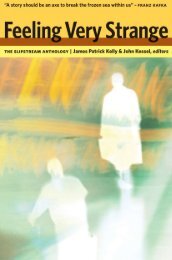The Curse of the Wer.. - Site de Thomas - Free
The Curse of the Wer.. - Site de Thomas - Free
The Curse of the Wer.. - Site de Thomas - Free
Create successful ePaper yourself
Turn your PDF publications into a flip-book with our unique Google optimized e-Paper software.
50 THE CURSE OF THE WEREWOLF<br />
in drinking a dog laps, whereas a wolf sucks, and in biting <strong>the</strong> wolf gives<br />
a rapid succession <strong>of</strong> vicious snaps, instead <strong>of</strong> <strong>the</strong> firm, retaining hold<br />
which generally characterizes <strong>the</strong> bite <strong>of</strong> a healthy dog. <strong>The</strong> character<br />
<strong>of</strong> <strong>the</strong> bark also differs greatly, <strong>the</strong> honest dog-bark being replaced by a<br />
short snapping, while <strong>the</strong> wolf voice is chiefly exerted in producing dismal<br />
howls. As regards external appearance … <strong>the</strong> cruel treacherous expression<br />
<strong>of</strong> <strong>the</strong> obliquely-set eyes betrays how different is <strong>the</strong> wolf-spirit from that<br />
which looks out through <strong>the</strong> kind true eyes <strong>of</strong> <strong>the</strong> faithful dog. 20<br />
Nineteenth-century representations <strong>of</strong> lycanthropy drew from such<br />
characterizations <strong>of</strong> <strong>the</strong> wolf, so that whenever a werewolf was discovered<br />
in its lupine form, it was <strong>de</strong>scribed in similar terms. G.W.M.<br />
Reynolds’s Wagner <strong>the</strong> Wehr-Wolf, for example, is variously <strong>de</strong>scribed<br />
as a ‘ferocious’ or ‘infuriate’ monster, a ‘monstrous’ wolf <strong>of</strong> ‘appalling<br />
ferocity’ and as ‘<strong>the</strong> <strong>de</strong>stroyer’. 21 Similarly, <strong>the</strong> she-wolf in Campbell’s<br />
story ‘has gleaming tusks and a pair <strong>of</strong> yellow eyes that blazed with<br />
lurid fire’. 22<br />
As all <strong>the</strong>se examples from narratives about lycanthropy <strong>de</strong>monstrate,<br />
<strong>the</strong> werewolf, like o<strong>the</strong>r monsters, embodied a composite<br />
O<strong>the</strong>rness which gave expression to anxieties about working-class<br />
<strong>de</strong>generacy, aristocratic <strong>de</strong>ca<strong>de</strong>nce, racial atavism, women’s corporeality<br />
and sexuality, and <strong>the</strong> human relationship to <strong>the</strong> animal world.<br />
<strong>The</strong> physical <strong>de</strong>fects or stigmata <strong>of</strong> <strong>the</strong> werewolf’s human incarnation<br />
suggested <strong>the</strong> presence <strong>of</strong> <strong>the</strong> interior beast, much as bumps on <strong>the</strong><br />
skull or facial characteristics were interpreted by phrenologists as<br />
evi<strong>de</strong>nce <strong>of</strong> interior characteristics and ten<strong>de</strong>ncies. In<strong>de</strong>ed, <strong>the</strong> process<br />
by which such <strong>de</strong>scriptions were drawn was satirized as early as 1855<br />
by Dudley Costello, in his short story ‘Lycanthropy in London; Or, <strong>the</strong><br />
Wehr-Wolf <strong>of</strong> Wilton-Crescent’, in which Miss A<strong>de</strong>la Cunninghame<br />
relies upon ‘her fatal skill in physiognomy’ to assess <strong>the</strong> character <strong>of</strong><br />
her friend’s new husband, Mr Fitz-Poodle. 23 ‘His sharp nose, his small<br />
eyes, his sandy eyebrows, his large teeth, his wiry hair, and his yellow<br />
whiskers, were severally objects <strong>of</strong> dislike to Miss Cunninghame’, to<br />
<strong>the</strong> extent that she says to herself ‘Very like a wolf! … I must observe<br />
his habits.’ 24 A<strong>de</strong>la’s suspicions that Mr Fitz-Poodle is a werewolf are<br />
subsequently confirmed when she notes that he consumed his food





